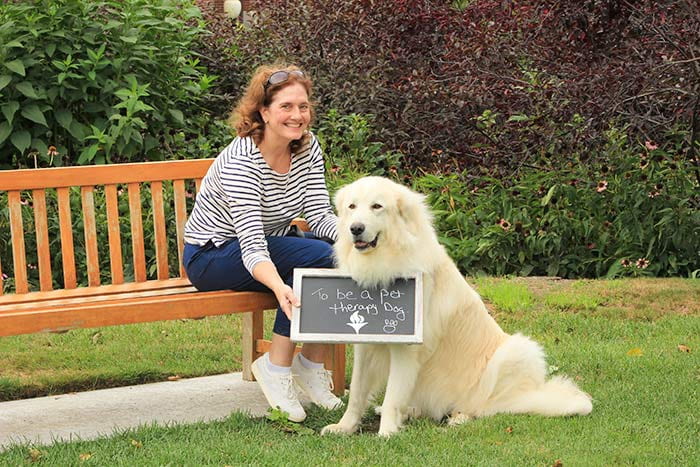Pet-Assisted Therapy

Pet-Assisted Therapy
Enhance your interactions with clients, students, and others in need with the help of your therapy pet
The Pet Assisted Therapy Certificate—officially called the DJ Professional Pet Assisted Therapy Certificate (“DJ” was the name of the first dog to complete the program)—is a three-course, non-credit program that trains human and pet teams in the theoretical and practical aspects of pet assisted therapy (PAT). Teams who successfully complete the program are eligible for credentialing through the Windwalker Humane Coalition for Professional Pet Assisted Therapy.
This training was primarily created for human service professionals, such as social workers, clinical or school psychologists, home health aides, and others who want to enhance their interactions with clients or students through the love of their therapy pet. However, this program is open to anyone wishing to share their pet for the support of others, especially seniors, veterans, children, the disabled, or those grieving.
PROGRAM SCHEDULE
Pet Assisted Therapy (PAT) I: Family Therapy Pets – The Ethical Foundation of PAT *
Wednesdays, Sept. 6 – Nov. 8, 2023
6:30 pm-8:45 PM
*A consultative appointment is required prior to enrolling in this program to ensure the program aligns with participant expectations. Make an appointment here.
This course covers the bond between humans and companion animals from the perspectives of history, research, ethics, safety and legal issues, and application of Pet Assisted Therapy. The format includes lectures, discussions, videos, guest speakers, visits with credentialed family therapy pets, and possible field trips.
Credentialing, insurance and temperament testing of pets are also addressed. By the end of Course I, students will learn how to set up safe and effective goal-oriented, treatment-based programs in a variety of settings. Students must pass PAT I and the pet must pass the temperament testing before proceeding to PAT II. Temperament testing for pets is held off-site.
Pet Assisted Therapy II: Building the Bond: Hands-On/Paws-On Learning
Thursdays, Sept. 7 – Oct. 26
5:30-7:30 PM
Pre-requisite: PAT I
This 8-week, hands-on course applies the concepts learned in PAT I to working with animals and prepares students for the internship. The family therapy pet and guardian (owner) work together to become acclimated to the sights, sounds and situations encountered in agencies, hospitals and schools, including wheelchairs, school bells, elevators and stairs, as well as practice approaching a patient in bed. The class includes training in pet therapy skills, basic obedience and lectures on animal behavior, and how to “read” the pet. There will be a mid-term as well as a final competency evaluation.
Pet Assisted Therapy (PAT) III: Internship: Experiencing the Joy
Date and Time TBA
Pre-requisite: PAT II
This 20-hour, off-site internship experience spans six months and is divided into two segments.
Part A (10 hours, generally one hour a week): Part A is typically held at one of the approved training sites. Under the supervision of a highly qualified mentor, students provide PAT treatment with supervision and will additionally learn about PAT guidelines, referrals, goal setting and documentation.
Part B (10 hours, generally one hour a week) requires the completion of Part A. Students work with the internship coordinator (instructor) to create their own PAT program in a facility which previously has not had one, based on their pet’s personality and interests. Teams then implement the PAT plan they just developed under the supervision of the internship coordinator.
This internship is scheduled individually.
Contact Us for more information(opens in a new tab)




